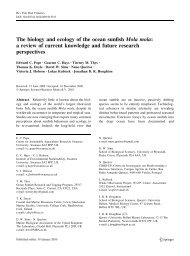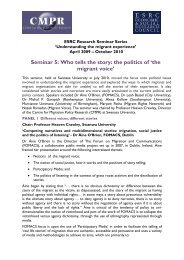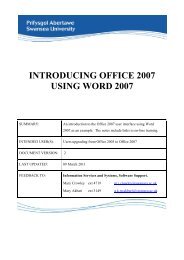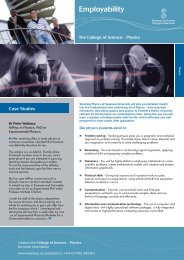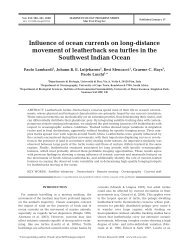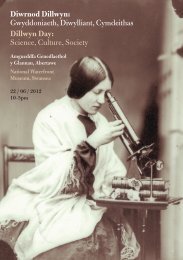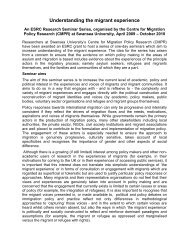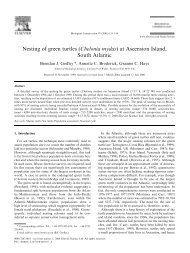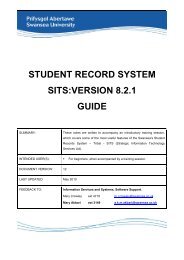The energy density of jellyfish - Swansea University
The energy density of jellyfish - Swansea University
The energy density of jellyfish - Swansea University
Create successful ePaper yourself
Turn your PDF publications into a flip-book with our unique Google optimized e-Paper software.
250 T.K. Doyle et al. / Journal <strong>of</strong> Experimental Marine Biology and Ecology 343 (2007) 239–252<br />
provide a good benchmark for comparison with bombcalorimetry<br />
values.<br />
Although bomb-calorimetry is frequently used to<br />
quantify the <strong>energy</strong> <strong>density</strong> <strong>of</strong> a wide range <strong>of</strong> taxa,<br />
estimates for <strong>jellyfish</strong> (and other gelatinous zooplankton)<br />
have previously been problematic due to the low<br />
<strong>energy</strong> <strong>density</strong> <strong>of</strong> samples, uneven distribution <strong>of</strong> the<br />
inorganic and organic matter in the dried samples and<br />
the fact that some residual/bound ‘water <strong>of</strong> hydration’<br />
always remains after the drying process (Clarke et al.,<br />
1992; Lucas, 1994; Arai, 1997). Our corrected estimates<br />
<strong>of</strong> <strong>energy</strong> <strong>density</strong> derived from bomb-calorimetry<br />
ranged from 2.91 to 5.07 kJ g DM − 1 . <strong>The</strong>se values<br />
are comparable to our proximate composition values<br />
and the few published estimates obtained from proximate-composition<br />
and carbon content analysis: 2.3–<br />
6.0 kJ g DM − 1 (Clarke et al., 1992; Arai, 1997) and<br />
suggest that with suitable modification (outlined in<br />
methods), bomb-calorimetry can provide reliable estimates<br />
<strong>of</strong> <strong>energy</strong> <strong>density</strong> for <strong>jellyfish</strong>.<br />
Importantly, these results highlight differences in<br />
<strong>energy</strong> <strong>density</strong> both between species and between body<br />
components. For example, whole C. capillata <strong>jellyfish</strong><br />
were almost twice as nutritious as C. hysoscella (<strong>energy</strong><br />
densities 0.22 and 0.12 kJ g wet mass − 1 respectively),<br />
and C. capillata bell tissue had ∼5 times less <strong>energy</strong><br />
than either gonad or oral arm tissue. In short, our <strong>jellyfish</strong><br />
<strong>energy</strong> densities illustrate the variation between seemingly<br />
similar species and reiterate the importance for<br />
collecting <strong>energy</strong> <strong>density</strong> data for a wide range <strong>of</strong> species<br />
and their associated tissues (Tierney et al., 2002).<br />
Both our bomb-calorimetry and proximate-composition<br />
<strong>energy</strong> estimates confirm that <strong>jellyfish</strong> have a very<br />
low <strong>energy</strong> <strong>density</strong> when compared with other taxa and<br />
foodstuffs (Table 6). This low <strong>energy</strong> <strong>density</strong> is a<br />
combination <strong>of</strong> (a) the high ash content, so that <strong>energy</strong><br />
densities per g dry mass are low, and also the high water<br />
content which means that low <strong>energy</strong> densities per g dry<br />
mass translate to even lower relative <strong>energy</strong> densities on<br />
a wet mass basis (Table 7). For example, <strong>jellyfish</strong> may<br />
have up to 58 times less <strong>energy</strong> per gram <strong>of</strong> wet mass<br />
than herring flesh.<br />
<strong>The</strong> clear relationship we found between <strong>jellyfish</strong><br />
<strong>energy</strong> <strong>density</strong> and ash content, suggests that ash<br />
content, which is cheap and easy to measure, may<br />
provide a good proxy for <strong>jellyfish</strong> <strong>energy</strong> <strong>density</strong> where<br />
other data are lacking. <strong>The</strong> search for similar proxies for<br />
<strong>energy</strong> <strong>density</strong> in others groups is well developed. For<br />
example, for fish in the north Pacific there are strong<br />
negative relationships between <strong>energy</strong> <strong>density</strong> and both<br />
ash free dry weight and ash contents (Van Pelt et al.,<br />
1997). In the absence <strong>of</strong> other data, therefore, the<br />
empirical relationship we established: Energy (kJ g wet<br />
mass − 1 )=1.21–0.0132 (% revised ash) can be used to<br />
estimate <strong>jellyfish</strong> <strong>energy</strong> <strong>density</strong>.<br />
Although <strong>jellyfish</strong> as a food resource may seem very<br />
improbable with such low <strong>energy</strong> densities, some<br />
animals have adopted anatomical, physiological and/or<br />
behavioural adaptations to survive on food items that are<br />
equally as energetically challenging. For example, the<br />
koala (Phascolarctos cinereus) survives exclusively on<br />
a nutritionally taxing diet <strong>of</strong> eucalyptus leaves (low in<br />
protein and high in deterrent compounds such as<br />
terpenes) by being inactive for up to 20 h a day, moving<br />
slowly, and possessing a large cecum (the most<br />
capacious <strong>of</strong> any mammal) with a microbial fauna that<br />
aids digestion efficiency (Ullrey et al., 1981; Lawler<br />
et al., 1998; Feldhamer et al., 1999). <strong>The</strong> white rhino<br />
(Ceratotherium simum), a non-ruminant and the largest<br />
extant ‘pure grass feeder’ can attain a size <strong>of</strong> 2300 kg on<br />
this low quality food source by foraging 50% <strong>of</strong> the diel<br />
cycle (Shrader et al., 2006). So for some, particularly<br />
large animals, survival may be simply a matter <strong>of</strong><br />
quantity, rather than quality <strong>of</strong> prey (Shrader et al.,<br />
2006). Indeed, larger animals can survive better on<br />
lower quality foods than smaller animals as body size<br />
helps determine metabolic requirements (Nagy et al.,<br />
1999). It is therefore perhaps unsurprising that the<br />
Table 7<br />
Tissue C. capillata R. octopus C. hysoscella<br />
(a) Mean GE kJ g DM −1 (n, ±S.D.)<br />
Gonad (PC) 8.14 (11, 1.81) 3.68 (3, 1.81) –<br />
Oral arms (PC) 8.84 (11, 0.74) 3.89 (3, 0.04) –<br />
Bell (PC) 2.44 (11, 0.41) 2.06 (3, 0.57) –<br />
Whole (PC) 4.87 (11, 0.85) 3.21 (3, 0.65) –<br />
Gonad (BC) 7.55 (10, 1.81) 6.33 (3, 2.39) 5.61 (10, 1.37)<br />
Oral arms (BC) 7.98 (7, 1.65) 4.10 (7, 1.48) 2.26 (9, 1.21)<br />
Bell (BC) 1.64 (8, 0.60) 2.12 (7, 1.31) 1.15 (10, 1.31)<br />
Whole (BC) 4.22 (7, 0.98) 2.80 (3, 1.05) 2.42 (10, 0.68)<br />
(b) Mean GE kJ g WM −1 (n, ±S.D.)<br />
Gonad (PC) 0.42 (11, 0.08) 0.20 (3, 0.11) –<br />
Oral arms (PC) 0.42 (11, 0.08) 0.16 (3, 0.01) –<br />
Bell (PC) 0.09 (11, 0.02) 0.06 (3, 0.00) –<br />
Whole (PC) 0.20 (11, 0.04) 0.12 (3, 0.02) –<br />
Gonad (BC) 0.43 (10, 0.15) 0.38 (3, 0.28) 0.27 (10, 0.08)<br />
Oral arms (BC) 0.40 (7, 0.15) 0.17 (7, 0.06) 0.10 (9, 0.05)<br />
Bell (BC) 0.06 (8, 0.03) 0.07 (7, 0.05) 0.04 (10, 0.05)<br />
Whole (BC) 0.18 (7, 0.05) 0.11 (3, 0.04) 0.10 (10, 0.03)<br />
PC=proximate-composition, and BC=bomb-calorimetry assuming.<br />
(a): Mean gross <strong>energy</strong> (GE) <strong>density</strong> values for individual tissues and<br />
whole samples <strong>of</strong> C. capillata, R. octopus and C. hysoscella (expressed<br />
as kJ g dry mass − 1 , n, ±S.D.). (b): Mean gross <strong>energy</strong> (GE) <strong>density</strong><br />
values for individual tissues and whole samples <strong>of</strong> C. capillata, R.<br />
octopus and C. hysoscella (expressed as kJ g wet mass − 1 ).



